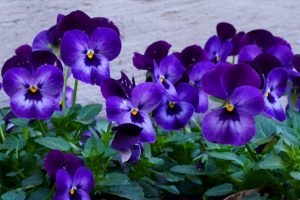Known by several names, including the winged euonymus and Euonymus alatus, the Burning Bush is one of the most beautiful plants in the garden. The bush gleams a fiery crimson that catches everyone’s attention. The vibrant display of this shrub, which lasts for months, is its finest feature! The shrub has stunning autumn color, but it also sports a gorgeous shade of green throughout the spring and summer. The Burning Bush plant has many additional appealing characteristics in addition to its color. This shrub requires very little upkeep and is quite resilient. It also doesn’t give headaches. The Burning Bush is a plant that grows quickly. The Burning Bush is a versatile plant that may be easily incorporated into any kind of landscape. It will undoubtedly draw attention away from anything else around and turn your yard into the talk of the neighborhood, so be prepared. Get some advice on how to take care of, prune, and more for burning shrubs.
Sunlight Requirements
For optimal growth, the Burning Bush prefers full sun to moderate shade. When planted and nurtured in full sunshine, it grows and takes on its characteristic vivid red hue. However, in places that get a few hours of shade each day, it may get quite red. This colorful shrub thrives in locations with intense afternoon sun followed by little shade. Although Burning Bushes thrive in the shade, prolonged shadowing will impede the expected brilliant autumn foliage. An excessive amount of shade might result in a more faded reddish pink. Despite being a lovely color, it lacks the impact of the vivid red color for which it is known.

Soil Conditions
The shrub known as the Burning Bush is very versatile. It doesn’t cause any issues or worries when planted in a range of soil types. It likes soil that drains well. The Burning Bush does not grow differently depending on the PH levels of the soil. Although this shrub may thrive in any kind of soil, it does prefer acidic soil with a PH of 6.0 to 6.5.
Requirements for Watering
Once grown, Burning Bush requires minimal irrigation and may withstand severe droughts. It is also quite resilient to a wide range of climates. Burning Bush will be easy to cultivate for homeowners around the nation.
How to Utilize the Hottest Beauty Tool on TikTok, Per Experts
Bush Pruning with Burning
As mentioned above, the burning bush is a plant that requires little upkeep. But like everything else, it needs some care. When to cut back on flaming shrubs. Your Burning Bush will remain healthy and attractive if you prune it in late winter or early spring. Failing to do so may result in more effort later on.
Getting Rid of Burning Bushes
There are four levels of trimming that your Burning Bush can need.
Minimal Pruning
It basically comes down to keeping the Burning Bush in its natural form with little trimming. You may do this at any time of the year. Maintaining the contour of the shrub in the summer requires trimming overgrown branches back to the original shape. We advise chopping branches at a 45-degree angle so that water may flow off them more readily.
Regular Pruning
Before new growth appears, routine trimming is carried out, often in late winter or early spring. You remove any sick or dead timber at this time. Pruning sick or dead plant portions or removing dead wood near the main branch promotes the formation of a healthy bud, which in turn promotes the growth of healthy wood. This basically produces a robust Burning Bush. Annual routine trimming helps avoid major issues that will need more attention and effort.
Thorough Pruning
Your Burning Bush needs more intrusive trimming in order to be revitalized if it has been neglected, which commonly happens when normal pruning is ignored. Before new growth appears, heavy pruning must be done in the late winter or early spring. You must trim one-third of the young canes that are emerging from the ground up to the base of the burning bush. Pruning shears or a pruning saw are required for this. This increases air circulation and lets light into the heart of the bush. You are also in charge of the shrub’s density and size at the same time.
Extreme Pruning
When the Burning Bush is severely neglected, this happens. Usually, the shrub is sickly or overgrown at this time. In early spring, you have to chop the whole Burning Bush down to the ground using a saw. This allows you plenty of growing time for fresh growth.
Ideas for Burning Bush Landscaping
Do you need landscaping ideas for Burning Bush? One of the bushes that has several potential uses is the burning bush. This plant is even more amazing because of its tolerance, size, and adaptability. The eye-catching Burning Bush may be used for any purpose and anyplace in your environment. The Burning Bush is excellent for formal planting, mass planting, borders, entryways, privacy hedges, and foundation planting.
For both small and big homes, burning bushes make excellent borders and hedges. If you decide to use these bushes as your border, we advise spacing them 5–6 feet apart. To make a hedge, space multiple Burning Bushes one foot apart. These vibrant bushes are excellent choices for a hedge. They develop into tidy, compact hedges that need very little upkeep since they are so thick.The Burning Bush is an excellent option for a focal point in your yard because of its organic spherical form. The striking crimson beauty may draw attention even when it is not surrounded by other plants. This plant is an excellent example. Your once-mediocre yard will become the talk of the neighborhood with The Burning Bush. You might also put the Burning Bush in the middle of your garden. Plant flowers all around it that have the same stunning autumn hues.
juniper planting and bush burningThe Burning Bush is very adaptable and tolerant of pollutants and weather, making it ideal for urban environments. Problems that sometimes impede other plants pose no obstacles for this resilient shrub. It is the ideal option for everyone, wherever.
It is crucial to choose plants that go well with the Burning Bush if you wish to add more to your yard. The vibrant red hue of the Burning Bush outshines that of most other plants. There are, nonetheless, certain plants that work nicely along with the Burning Bush bush.
With the Burning Bush, evergreens, woody trees, and a few colorful trees blend in well. Evergreens complement the Burning Bush well. They provide the ideal amount of contrast to bring off the brilliant red of the Burning Bush! Evergreens have dark green, fluffy needles and are tall, almost pyramidal in shape. They go well with the Burning Bush, which has smooth red leaves and is erect, compact, and spherical. When the Burning Bush begins to lose its leaves, the lovely evergreen will provide a stunning background for the bare branches. We recommend Japanese Cryptomeria, Douglas Fir, or Deodora Cedar as appropriate evergreens. River Birch and Crape Myrtle work nicely together to give your area a forest-like atmosphere. These woody trees feature flaking bark, several stemmed trunks, and a peeling appearance. These characteristics work well along with the Burning Bush.
Getting Rid of a Burning Bush
Step 1: Clean Your Pruning Instruments
To avoid spreading illness to the burning shrub, sanitize your pruning equipment before beginning. To sanitize your shears or saws, use 70% isopropyl alcohol or a solution of 1 part bleach to 9 parts water.
Step 2: Scheduling Your Pruning Timewise
When pruning a burning bush, it is best to do it in late winter or early spring, just before new growth starts, to minimize stress on the plant and lower the chance of disease infection.
Step 3: Recognizing Inactive Branches
Find any dead branches on the burning bush that don’t have any buds or green wood visible. Compared to live branches, these branches are often more brittle, feel lighter, and have a distinct tint.
Step 4: Dead Branches Pruning Method
To promote appropriate water outflow and avoid disease, trim dead branches just above a healthy bud or the main stem, cutting at a 45-degree angle that slopes away from the bud.
Step 5: Recognizing Infected Plant Elements
Search for areas of the burning bush that are unhealthy. These areas might include branches with unusual growth, discoloration, or symptoms of a fungal infection like rust or mildew.
Step 6: Eliminating Contaminated Material
To make sure all of the contaminated material is eliminated, make cuts well below the sick sections that are impacted. To prevent the spread of germs, be sure to clean your instruments right away after cutting sick material.
Step 7: Removing Old, Unusable Wood
To encourage burning bush to create new, robust branches, remove any old wood that hasn’t generated any new growth in a number of years. Compared to younger wood, they are often thicker and have a rougher bark texture.
Step 8: Old Wood Cutting Technique
When chopping old wood, cut just above a lower leaf set or a side branch to reroute energy to the burning bush’s more active sections.
Step 9: Examining Plant Form After Pruning
After removing any dead, unhealthy, or old wood, look at the burning bush’s general shape to see whether it still needs to be shaped in order to keep its desired size or form.
Step 10: Sizing Up for Airflow and Light
To guarantee proper light and air circulation throughout the core of the burning bush, trim off congested branches judiciously. This will help avoid illness and promote even development.
Step 11: Pruning Waste Disposal
To stop any possible infections from spreading, dispose of any removed debris correctly. Composting diseased material is not advised. When you’re done, sterilize your pruning implements. Read more



